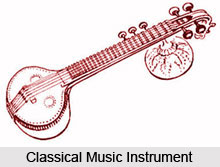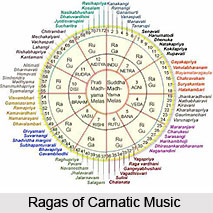 Carnatic music is one of the most ancient music systems in the world with its history dating back to the age old days of the Vedas. The well defined theoretical principles govern Carnatic music whilst adding to the practical and aesthetic appeal of this genre of Indian classical music.
Carnatic music is one of the most ancient music systems in the world with its history dating back to the age old days of the Vedas. The well defined theoretical principles govern Carnatic music whilst adding to the practical and aesthetic appeal of this genre of Indian classical music.The main element of Carnatic music is its melody. Melody in the context of Carnatic music may be explained as, "The production of any musical tone or succession of such tones or semitones, with definite frequencies, within certain parameters, whether rendered independently or in conjunction with rhythm and / or lyrics". Carnatic music is typically a melody-based system where the stress is laid on the successive combination of notes. The melodic elements of Carnatic music are very systematic in their development from the simple to more complex and then ultimately utterly sophisticated. Quit ideally therefore the main emphasis in Carnatic music is on vocal music and on tonal expressions. The elements of Carnatic music thus rests on two aspect raaga, the modes and taala, the rhythmic cycles.
Elements of Carnatic music are as follows: Sruti: Sruti refers to musical pitch. In Carnatic music, ptch or sruti is of central concern and is an important element of Carnatic music. Every individual has a natural pitch which is his very own level or his range at which he can produce notes of best quality with optimum level of tonal ease. This becomes the fixed pitch and is called the Sruti.
Swara: Swara refers to a type of musical sound that is a single note, which defines a relative (higher or lower) position of a note, rather than a defined frequency. Swaras also refer to the solfege of Carnatic music, which consist of seven notes, "sa-ri-ga-ma-pa-da-ni" These names are abbreviations of the longer names shadja, rishabha, gandhara. madhyama, panchama, dhaivata and nishada.
Raag System: Raaga in Carnatic music prescribes a set of rules for building a melody. It specifies rules for movements up (aarohanam) and down (avarohanam), the scale of which notes should figure more and which notes should be used more sparingly, which notes may be sung with gamaka, which phrases should be used, phrases should be avoided, and so on. In Carnatic music, the sampoorna ragas (those with all seven notes in their scales) are classified into a system called the melakarta, which groups them according to the kinds of notes that they have. The ragas are grouped into sets of six; called chakras ("wheels", though actually segments in the conventional representation) grouped according to the supertonic and mediant scale degrees. There is a system known as the 'Katapayadi sankhya to determine the names of Melakarta Raags.
Taal System: Taal or Tala refers to the beat set for a particular composition (a measure of time). Taals have cycles of a defined number of beats and rarely change within a song. They have specific components, which in combinations can give rise to the variety to exist (over 108), allowing different compositions to have different rhythms.
 Tala is formed with three basic parts (called angas), which are laghu, dhrtam, and anudhrtam, though complex talas may have other parts like plutam, guru and kaakapaadam. There are seven basic tala groups, which can be formed from the laghu, dhrtam, and anudhrtam:
Tala is formed with three basic parts (called angas), which are laghu, dhrtam, and anudhrtam, though complex talas may have other parts like plutam, guru and kaakapaadam. There are seven basic tala groups, which can be formed from the laghu, dhrtam, and anudhrtam:Kriti: Carnatic songs (kritis) are varied in structure and style, but generally consist of three units, which is Pallavi, Anupallavi and Charana. This kind of song is called a keerthana or a Kriti. There are other possible structures for a Kriti, which may in addition include swara passages named chittaswara. Chittaswara consists only of notes, and has no words. Others have a verse at the end of the charana, called the madhyamakala. It is sung immediately after the charana, but at double speed.
Varnam: This is a special item, which highlights everything important about a raga; not just the scale, but also which notes to stress, how to approach a certain note, classical and characteristic phrases, etc. Though there are a few different types of varnams, in essence, they all have a pallavi, an anupallavi, muktayi swaras, a charana, and chittaswaras. They are sung in multiple speeds, and very good for practice. In concerts, varnams are often sung at the beginning as they are fast and grab the audience's attention.
For more, visit the link below: